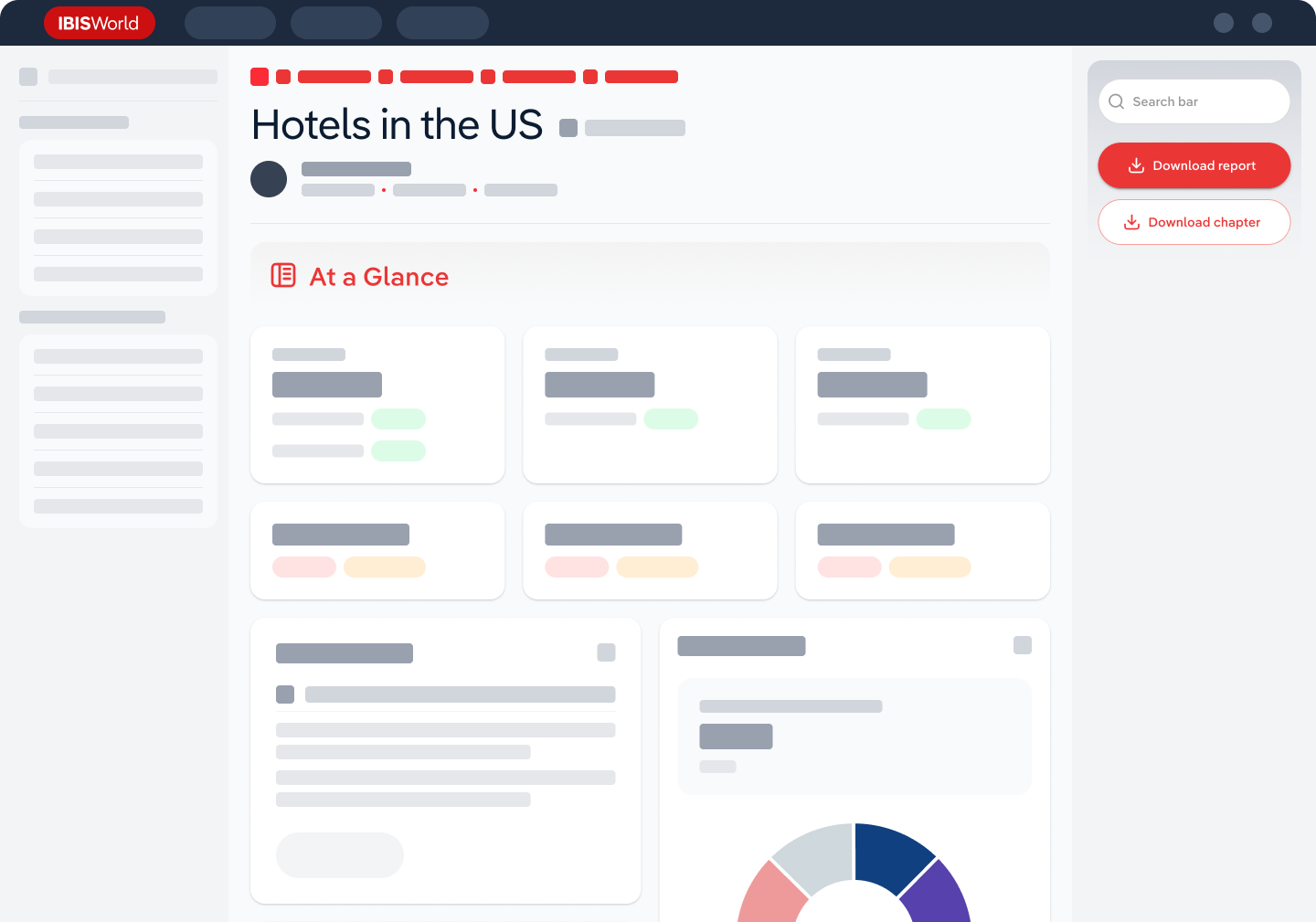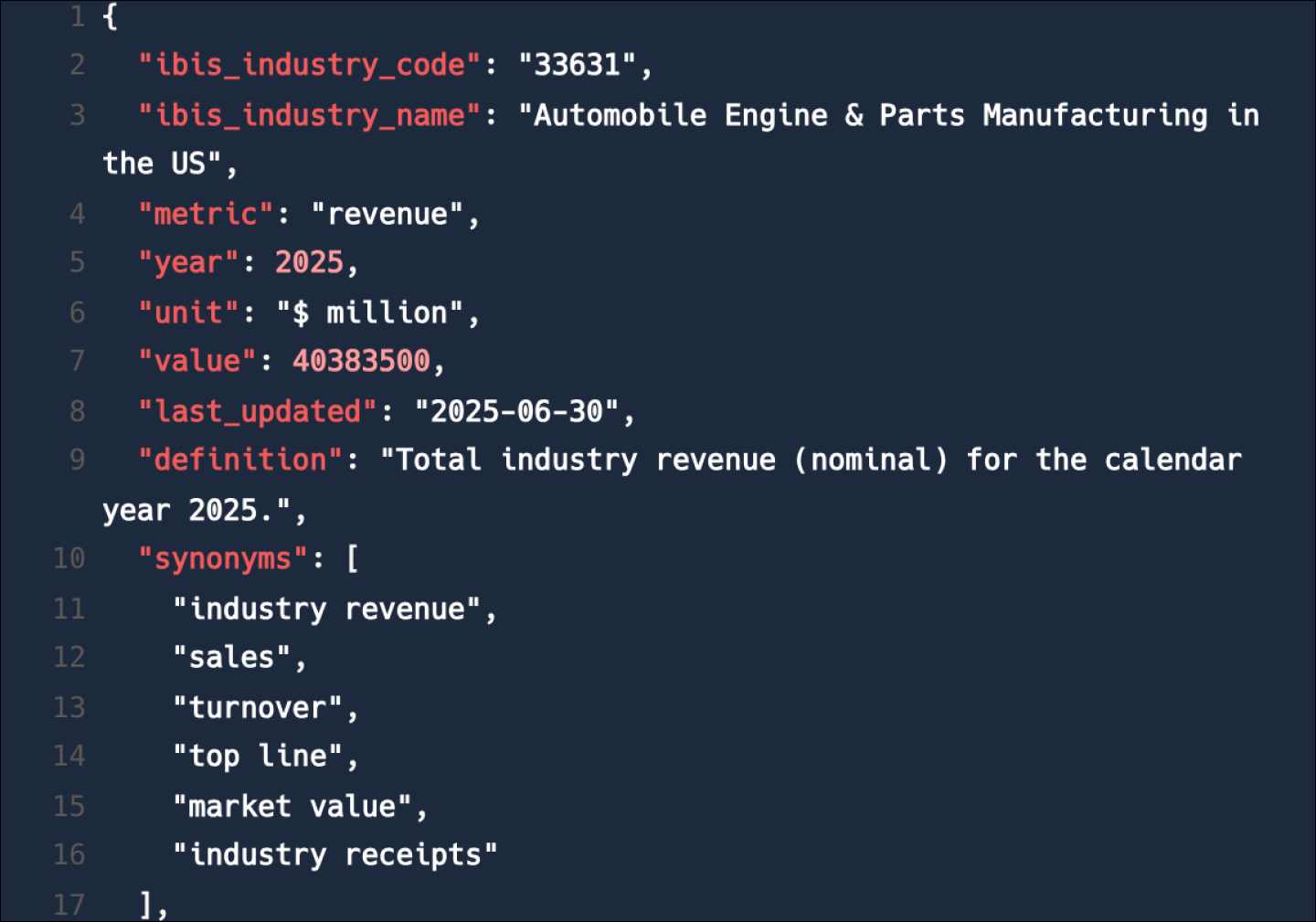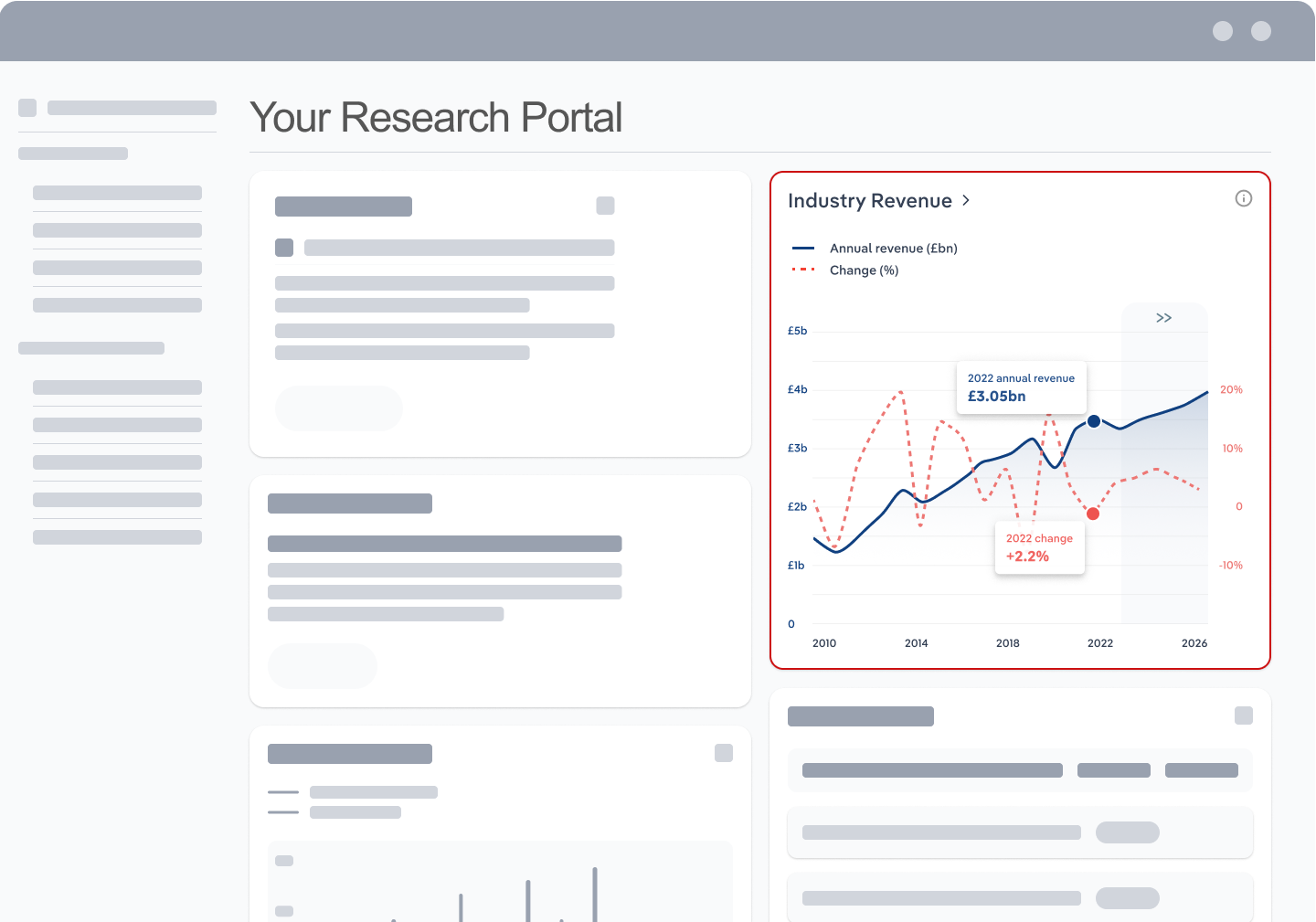Industry Statistics and Trends
Market size and recent performance (2015-2030)
Industry revenue has grown at a CAGR of 6.0 % over the past five years, to reach an estimated $95.9bn in 2025.
Trends and Insights
Tight cattle supplies from drought conditions and slow herd rebuilding sustain high prices
- Over the past five years, persistent drought conditions have severely impacted US cattle production, forcing widespread herd liquidation. According to the USDA’s January 2025 Cattle Inventory Report, beef cow numbers fell to 27.9 million head — their lowest level since 1965 — after years of drought in key cattle-producing states like Texas, Oklahoma and Nebraska. This contraction has reduced calf crops and feeder cattle availability, tightening overall supply.
- Additional trends and insights available with purchase
Industry outlook (2025-2030)
Market size is projected to decline over the next five years.
Trends and Insights
Expanding international supplies and herd rebuilding will reduce US beef prices
- The global beef market is projected to grow, with countries like Brazil and Australia increasing production to meet the rising global demand for affordable beef products. These nations benefit from lower production costs and favorable trade agreements, allowing them to expand their market share in key regions like Asia and Europe. Brazil will continue to dominate the global market as a low-cost producer, while Australia has recovered from herd rebuilding efforts and is regaining its export momentum.
Biggest companies in the Beef Cattle Production in the US
| Company | Market Share (%)
2025 | Revenue
2025 | Profit
2025 | Profit Margin (%)
2025 |
|---|
There are no companies that hold a market share exceeding 5% in the Beef Cattle Production in the US industry.
Products & Services Segmentation
Industry revenue is measured across several distinct product and services lines, including Steers, Heifers and Dairy cows. Steers is the largest segment of the Beef Cattle Production in the US.
Trends and Insights
Low beef cow headcounts constrain ranchers ability to rebuild herds
- Beef cows are mature females kept for breeding purposes on cow-calf operations. However, beef cow inventories remain historically low entering 2025 due to drought-induced herd liquidation in prior years. As of the USDA's January 2025 Cattle report, the beef cow herd stood at 27.9 million head — a 0.5% decline from 2024 and the lowest since 1965.
- More insights available in the full report
Table of Contents
About this industry
Industry definition
This industry includes farms and ranches that primarily raise cattle, including cattle for dairy herd replacements, or feed cattle and prepare them for consumption. It also includes cattle feedlot operations, which fatten cattle on high-energy rations before they are sold for slaughter.
What's included in this industry?
Products and services covered in the Beef Cattle Production industry in the United States include Cattle and calf ranching and farming, Feedlot operations, Backgrounding and conditioning cattle, Feeder, stocker and veal calf replacement and Dairy heifer replacement.Companies
Companies covered in the Beef Cattle Production industry in the United States include .Purchase this report to view all major companies in this industry.
Related Terms
Related terms covered in the Beef Cattle Production industry in the United States include feeder cattle, bovine spongiform encephalopathy, beef cow, stocker cattle, cow-calf operation, feedlot, backgrounding, breeding stock and fat/fed/finished cattle.Industry Code
NAICS 11211 - Beef Cattle Production in the US
Performance
Get an indication of the industry's health through historical, current and forward-looking trends in the performance indicators that make or break businesses.
Analyst insights
Droughts and expensive feed have challenged cattle farmers but boosted revenues. As limited supplies create an inflated market and farmers look to pass on increased costs to ...
In this chapter (4)
- Current Performance
- Outlook
- Volatility
- Life Cycle
Key metrics
- Annual Revenue, Recent Growth, Forecast, Revenue Volatility
- Number of Employees, Recent Growth, Forecast, Employees per Business, Revenue per Employee
- Number of Businesses, Recent Growth, Forecast, Employees per Business, Revenue per Business
- Total Profit, Profit Margin, Profit per Business
Charts
- Revenue, including historical (2015-2024) and forecast (2025-2030)
- Employees, including historical (2015-2024) and forecast (2025-2030)
- Businesses, including historical (2015-2024) and forecast (2025-2030)
- Profit, including historical (2015-2025)
- Industry Volatility vs. Revenue Growth
- Industry Life Cycle
Detailed analysis
- Trends in supply, demand and current events that are driving current industry performance
- Expected trends, economic factors and ongoing events that drive the industry's outlook
- Key success factors for businesses to overcome volatility
- How contribution to GDP, industry saturation, innovation, consolidation, and technology and systems influence the industry's life cycle phase.
Products and Markets
Learn about an industry's products and services, markets and trends in international trade.
Analyst insight
US cattle exports to China will face retaliatory tariffs. This significant gain in tariffs could threaten the competitiveness of US products, as it disrupts access to the gro...
In this chapter
- Products & Services
- Major Markets
- International Trade
Key metrics
- Largest market segment and value in 2025
- Product innovation level
- Total imports, level and trend
- Total exports, level and trend
- Trade Balance
Charts
- Products & services segmentation in 2025
- Major market segmentation in 2025
- International trade, including imports by country and exports by country
Detailed analysis
- Trends impacting the recent performance of the industry's various segments
- Innovations in the industry's product or service offering, specialization or delivery method
- Key factors that successful businesses consider in their offerings
- Buying segments and key trends influencing demand for industry products and services
- Recent trends in import and export volumes, country of origin or destination, and expected future trends
Geographic Breakdown
Discover where business activity is most concentrated in an industry and the factors driving these trends to find opportunities and conduct regional benchmarking.
Analyst insights
Climate and feed costs determine farm locations. The Plains and Southwest are the primary regions for cattle ranchers and feedlots because of their favorable climate and prox...
In this chapter (1)
- Business Locations
Charts
- Share of revenue, establishment, wages and employment in each state
- Share of population compared to establishments in each region in 2025
Tables
- Number and share of establishments in each state in 2025
- Number and share of revenue each state accounts for in 2025
- Number and share of wages each state accounts for in 2025
- Number and share of employees in each state in 2025
Detailed analysis
- Geographic spread of the industry across North America, and trends associated with changes in the business landscape
- Key success factors for businesses to use location to their advantage
Competitive Forces
Get data and insights on what's driving competition in an industry and the challenges industry operators and new entrants may face, with analysis built around Porter's Five Forces framework.
Analyst insights
Beef producers compete on quality, but cattle are largely commoditized and judged on price. Organic and grass-finished beef is becoming highly sought-after, but transitioning...
In this chapter (4)
- Concentration
- Barriers to Entry
- Substitutes
- Buyer & Supplier Analysis
Key metrics
- Industry concentration level
- Industry competition level and trend
- Barriers to entry level and trend
- Substitutes level and trend
- Buyer power level and trend
- Supplier power level and trend
Charts
- Market share concentration among the top 4 suppliers from 2020-2025
- Supply chain including upstream supplying industries and downstream buying industries, flow chart
Detailed analysis
- Factors impacting the industry’s level of concentration, such as business distribution, new entrants, or merger and acquisition activity.
- Key success factors for businesses to manage the competitive environment of the industry.
- Challenges that potential industry entrants face such as legal, start-up costs, differentiation, labor/capital intensity and capital expenses.
- Key success factors for potential entrants to overcome barriers to entry.
- Competitive threats from potential substitutes for the industry’s own products and services.
- Key success factors for how successful businesses can compete with substitutes.
- Advantages that buyers have to keep favorable purchasing conditions.
- Advantages that suppliers have to maintain favorable selling conditions.
- Key success factors for how businesses can navigate buyer and supplier power.
Companies
There are no companies that hold a market share exceeding 5% in the Beef Cattle Production in the US industry.
Analyst insights
The cattle production industry is primarily composed of small, family-owned operators. Most operations are regional, though they may collaborate through co-ops to leverage ec...
External Environment
Understand the demographic, economic and regulatory factors that shape how businesses in an industry perform.
Analyst insights
The quality of beef is closely monitored. Cattle farmers need to ensure proper feeding and treatment of livestock to avoid massive fines and reputation damage.
In this chapter
- External Drivers
- Regulation & Policy
- Assistance
Key metrics
- Regulation & policy level and trend
- Assistance level and trend
Charts
- Regulation & Policy historical data and forecast (2015-2030)
- Assistance historical data and forecast (2015-2030)
Detailed analysis
- Demographic and macroeconomic factors influencing the industry, including Regulation & Policy and Assistance
- Major types of regulations, regulatory bodies, industry standards or specific regulations impacting requirements for industry operators
- Key governmental and non-governmental groups or policies that may provide some relief for industry operators.
Financial Benchmarks
View average costs for industry operators and compare financial data against an industry's financial benchmarks over time.
Analyst insights
Profit can change significantly from year to year. Large feedlots benefit from economies of scale that reduce costs, but the volatility of the price of feed is still difficul...
In this chapter
- Cost Structure
- Financial Ratios
- Key Ratios
Key metrics
- Profit margin, and how it compares to the sector-wide margin
- Average wages, and how it compares to the sector-wide average wage
- Largest cost component as a percentage of revenue
- Industry average ratios for days' receivables, industry coverage and debt-to-net-worth ratio
Charts
- Average industry operating costs as a share of revenue, including purchases, wages, depreciation, utilities, rent, other costs and profit in 2025
- Average sector operating costs as a share of revenue, including purchases, wages, depreciation, utilities, rent, other costs and profit in 2025
- Investment vs. share of economy
Data tables
- Industry Multiples (2018-2023)
- Industry Tax Structure (2018-2023)
- Income Statement (2018-2023)
- Balance Sheet (2018-2023)
- Liquidity Ratios (2018-2023)
- Coverage Ratios (2018-2023)
- Leverage Ratios (2018-2023)
- Operating Ratios (2018-2023)
- Cash Flow & Debt Service Ratios (2015-2030)
- Revenue per Employee (2015-2030)
- Revenue per Enterprise (2015-2030)
- Employees per Establishment (2015-2030)
- Employees per Enterprise (2015-2030)
- Average Wage (2015-2030)
- Wages/Revenue (2015-2030)
- Establishments per Enterprise (2015-2030)
- IVA/Revenue (2015-2030)
- Imports/Demand (2015-2030)
- Exports/Revenue (2015-2030)
Detailed analysis
- Trends in the cost component for industry operators and their impact on industry costs and profitability
Key Statistics
Industry Data
Data Tables
Including values and annual change:
- Revenue (2015-2030)
- IVA (2015-2030)
- Establishments (2015-2030)
- Enterprises (2015-2030)
- Employment (2015-2030)
- Exports (2015-2030)
- Imports (2015-2030)
- Wages (2015-2030)
Top Questions Answered
Unlock comprehensive answers and precise data upon purchase. View purchase options.
What is the market size of the Beef Cattle Production industry in the United States in 2025?
The market size of the Beef Cattle Production industry in the United States is $95.9bn in 2025.
How many businesses are there in the Beef Cattle Production industry in the United States in 2025?
There are 532k businesses in the Beef Cattle Production industry in the United States, which has declined at a CAGR of 3.0 % between 2020 and 2025.
How may import tariffs affect the Beef Cattle Production industry in the United States?
The Beef Cattle Production industry in the United States is unlikely to be materially impacted by import tariffs with imports accounting for a low share of industry revenue.
How may export tariffs affect the Beef Cattle Production industry in the United States?
The Beef Cattle Production industry in the United States is unlikely to be materially impacted by export tariffs with exports accounting for a low share of industry revenue.
Has the Beef Cattle Production industry in the United States grown or declined over the past 5 years?
The market size of the Beef Cattle Production industry in the United States has been growing at a CAGR of 6.0 % between 2020 and 2025.
What is the forecast growth of the Beef Cattle Production industry in the United States over the next 5 years?
Over the next five years, the Beef Cattle Production industry in the United States is expected to decline.
What does the Beef Cattle Production industry in the United States include?
Cattle and calf ranching and farming and Feedlot operations are part of the Beef Cattle Production industry in the United States.
How competitive is the Beef Cattle Production industry in the United States?
The level of competition is high and steady in the Beef Cattle Production industry in the United States.
Methodology
How are IBISWorld reports created?
IBISWorld has been a leading provider of trusted industry research for over 50 years to the most successful companies worldwide. With offices in Australia, the United States, the United Kingdom, Germany and China, we are proud to have local teams of analysts that conduct research, data analysis and forecasting to produce data-driven industry reports.
Our analysts start with official, verified and publicly available sources of data to build the most accurate picture of each industry. Analysts then leverage their expertise and knowledge of the local markets to synthesize trends into digestible content for IBISWorld readers. Finally, each report is reviewed by one of IBISWorld’s editors, who provide quality assurance to ensure accuracy and readability.
IBISWorld relies on human-verified data and human-written analysis to compile each standard industry report. We do not use generative AI tools to write insights, although members can choose to leverage AI-based tools within the platform to generate additional analysis formats.
What data sources do IBISWorld analysts use?
Each industry report incorporates data and research from government databases, industry-specific sources, industry contacts, and our own proprietary database of statistics and analysis to provide balanced, independent and accurate insights.
Key data sources in the US include:
- US Census Bureau
- US Bureau of Labor Statistics
- US International Trade Commission
Analysts also use industry specific sources to complement catch-all sources, although their perspective may focus on a particular organization or representative body, rather than a clear overview of all industry operations. However, when balanced against other perspectives, industry-specific sources provide insights into industry trends.
These sources include:
- Industry and trade associations
- Industry federations or regulators
- Major industry players annual or quarterly filings
Finally, IBISWorld’s global data scientists maintain a proprietary database of macroeconomic and demand drivers, which our analysts use to help inform industry data and trends. They also maintain a database of statistics and analysis on thousands of industries, which has been built over our more than 50-year history and offers comprehensive insights into long-term trends.
How does IBISWorld forecast its data?
IBISWorld’s analysts and data scientists use the sources above to create forecasts for our proprietary datasets and industry statistics. Depending on the dataset, they may use regression analysis, multivariate analysis, time-series analysis or exponential smoothing techniques to project future data for the industry or driver. Additionally, analysts will leverage their local knowledge of industry operating and regulatory conditions to impart their best judgment on the forecast model.
IBISWorld prides itself on being a trusted, independent source of data, with over 50 years of experience building and maintaining rich datasets and forecasting tools. We are proud to be the keystone source of industry information for thousands of companies across the world.
Learn more about our methodology and data sourcing on the Help Center.










